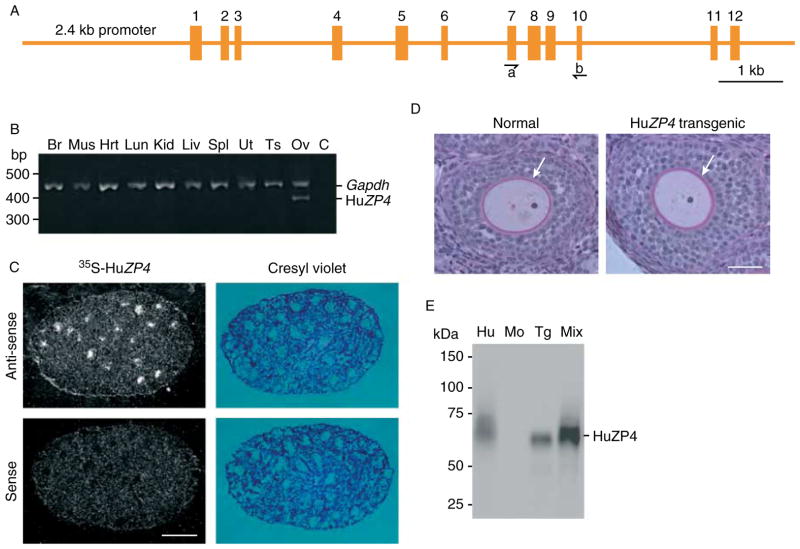Figure 1.
Transgenic mice expressing human ZP4. (A) Schematic of 11.6 kb human ZP4 gene locus composed of a 2.4 kb promoter, 8.2 kb coding region, and 1.0 kb 3′ of the last exon. Exons are indicated by Arabic numbers and PCR primers by arrowheads. (B) Tissue-specific expression of human ZP4 was determined by RT-PCR. Total RNA was isolated from the brain (Br), muscle (Mus), heart (Hrt), lung (Lun), kidney (Kid), liver (Liv), spleen (Spl), uterus (Ut), testes (Ts), and ovary (Ov) of transgenic mice. Ovarian RNA without reverse transcriptase was a negative control (C). After RT to obtain ssDNA, PCR amplification was performed with exon-specific primers (A) to distinguish ssDNA (485 bp) from genomic DNA (1052 bp). Gapdh expression (572 bp) was used as an internal control for RNA integrity and quantity. Molecular mass markers are indicated at the left. (C) In situ hybridization of normal and human ZP4 transgenic ovarian sections. Specific 35S-labeled sense and anti-sense human ZP4 cRNA probes were hybridized to OCT-embedded ovarian sections from 15-day-old transgenic females. Sections were viewed with bright- and darkfield microscopy. (D) Plastic-embedded ovarian sections from 3- to 4-week-old human ZP4 transgenic and normal female mice. Sections were stained with periodic-acid Schiff’s reagent to highlight the zona pellucida (arrow), surrounding developing oocytes and counterstained with hematoxylin. (E) Immunoblot of human and mouse eggs. Lane 1 (Hu), uninseminated, immature human oocyte (2); lane 2 (Mo), normal mouse eggs (30); lane 3 (Tg), human ZP4 transgenic eggs (30); and lane 4 (Mix), mixture of lanes 1 (Hu) and 3 (Tg). Blot was probed with a MAB specific to human ZP4 and detected with HRP-conjugated secondary antibodies and chemiluminescence. Molecular weights are indicated to the left.

